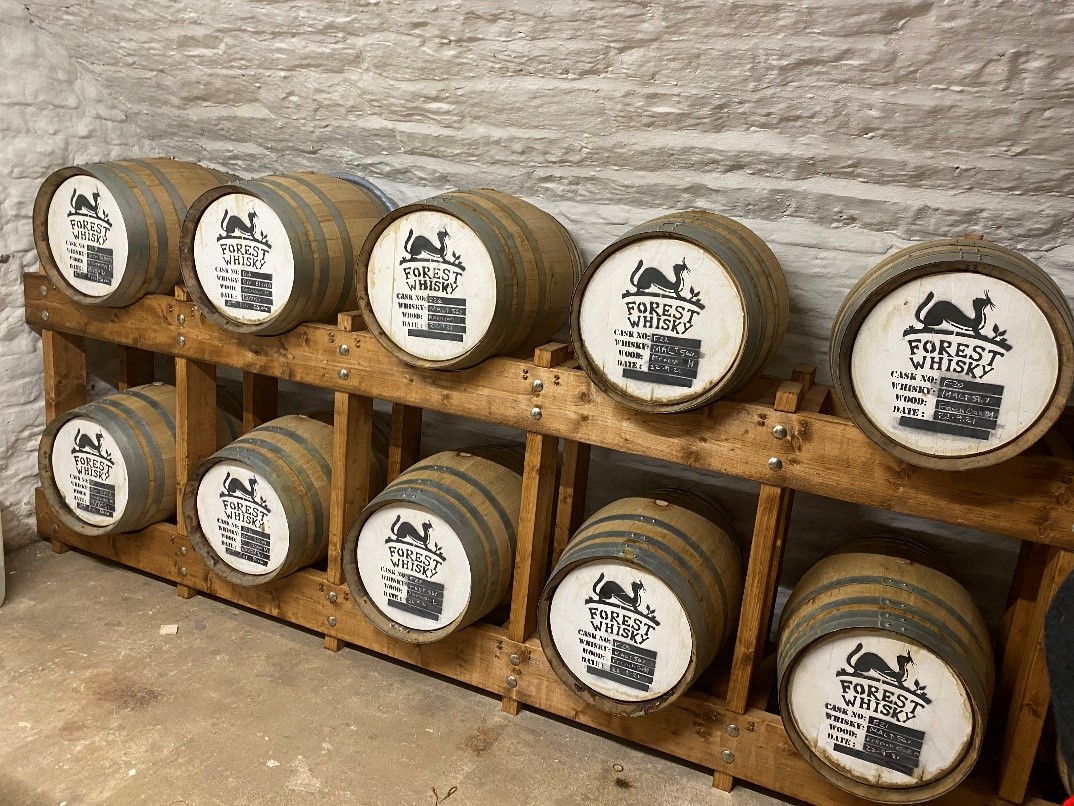Report back on meeting Dec 3rd 2021
It was challenging, no doubt about it. Heavy fog, freezing temperatures. Typical Peak District weather for December. And yet plenty of intrepid members gathered round a roaring fire at the Cat & Fiddle, and scoffed an excellent breakfast while listening to Karl Bond, owner of Forest Gin in Macclesfield, on his new venture at this historic pub on the A537. Wonder if the faint whiff of whisky in the air had anything to do with it..?

Nigel Eastmond, Phil Stanyer, Ajay Kapadia, Jaime Llull and Karl Bond in the cellars
So much of the Inn’s history, Karl said, isn’t written down, but recalled in folklore. Two thousand years ago the Romans trudged past, and no doubt others preceded them as local standing stones testify. When it became a turnpike connecting Macclesfield with Buxton, the current inn was built in 1813. Charles Rolls and Henry Royce used the road as an unofficial test track; the Rolls-Royce Society met there regularly for many years. The huge cellars were a necessity as the place would inevitably be snowed in, possibly for weeks on end, when meat and drink stores would keep the inhabitants alive.
It was believed to be England’s highest pub at over 1600 ft until satellite measurement downgraded it to second (the highest is Tan Hill in N Yorks). Robinson’s bought the pub in 1931 to sell their ales; it was a particular favourite of the business’s chairman William. But as others had found before them, to make any money from it as a pub, with or without food, was very hard. They eventually gave in and it closed on Christmas Eve 2014.
So when the Bond family took a long lease in late 2019, it wasn’t with the aim of running a hostelry. What struck them was the marvellous cellars, perfect for storing and maturing whisky, a product they had just started to make following their international award-winning gin business (see our report from January 2020). A distillery on this spacious but remote site could also be a safe and practical matter.
The place was… a wreck, then, and it was decided to ignore the main building to begin with, but to try crowd-funding to get production under way. To their delight, £50,000 was quickly raised, with the promise to investors of a bottle of the mature stuff when it is eventually released. Hard work meant everything was ready in March 2020. And then the pandemic struck.
This is where an entrepreneurial mind makes the difference between survival and failure. Instead of giving up, Karl and his staff got cracking to restore the pub building itself. They sold gin and other products out of the window and made deliveries to the more remote villages, building up a devoted clientèle. Once summer arrived with eased restrictions, a Gin Garden was opened at Buxton Pavilion and has been a roaring success. Motorcyclists in their hundreds have rediscovered the Cat and are liable to arrive all at once; the shop, selling their products and many more, locally sourced if possible, is a big draw. Instead of spending money on a chef, fresh pies are brought in daily from a local bakery. During 2021 they’ve had 50,000 vehicles check into the car park (which belongs to the council), and since lockdown started they’ve gone from 4 employees to 22.
The outcome now is stylish indeed. It’s a destination already, but Karl hopes to make it part of a whisky/gin tourism tour, bearing in mind that one of the most visited tourist attractions in the Lake District is the whisky distillery. He’s working with other English distillers to see if they can create a special, distinctive product; this is never going to be mass produced. In Aberdeenshire there’s already a whisky trail, but not as yet for the growing number of English distilleries. That may soon change.
Some pre-pandemic plans have been put to one side, including the idea of glamping holidays. The Cat’s business is making whisky; everything else is an extra and has to earn its keep. The distillery has been moved from the barn to indoors as they expanded and more room was needed for grain storage. Forest brand whisky in the iconic Wade porcelain bottle has started winning awards, including being chosen the Best World Whisky by The Independent Indy100; for the moment, it’s a blend.

Materials are sourced locally whenever possible – spring barley from Cheshire, wild yeast from the forest, and the water, which is peaty (“Not nice to drink..” Karl said). The peaty taste of Scotch comes traditionally from malting over burning peat, which is not permitted now, so other answers are being sought. The ingredients are just three: grain (which can be a mix of malt barley and oats), water and yeast. A “whisky mash” is created and then distilled, a two-week process which occupies three people continuously. It’s then put into casks and matured for at least three years.
And then we had a quick tour of the cellars… row after row of barrels big and small, each carefully labelled with the date, the grain and the type of cask, as the taste will vary depending on what filled them before – oloroso sherry, or cognac, American, French or English oak. “Getting hold of good casks is very tricky,” Karl said. Their English oak comes from Yorkshire and he’s hoping to source from Chatsworth. But it’s all a bit experimental, as nobody knows how the result will taste. “We can’t replicate what the Scots do, but we don’t need to. This is a specialty brand, and that’s its attraction.”
They do online ordering and delivery, and tables and tours of the site, which must be booked in advance via their website: https://theforestdistillery.com/distillery/. It’s a work in progress, but like the spirit in their barrels, it’s maturing nicely.
